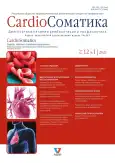The role of markers of endothelial dysfunction, oxidative and cellular stress in the prediction of myocardial infarction in comorbid patients with stable coronary heart disease
- Authors: Kotova Y.A.1, Zuikova A.A.1, Strahova N.V.1, Krasnorutskaya O.N.1, Esina E.Y.1
-
Affiliations:
- Burdenko Voronezh State Medical University
- Issue: Vol 12, No 1 (2021)
- Pages: 23-27
- Section: Original study articles
- URL: https://journals.rcsi.science/2221-7185/article/view/71023
- DOI: https://doi.org/10.26442/22217185.2021.1.200768
- ID: 71023
Cite item
Full Text
Abstract
Aim. To study the role of markers of endothelial dysfunction, oxidative and cellular stress in the prediction of myocardial infarction (MI) in comorbid patients with stable coronary heart disease (CHD).
Material and methods. The study involved 336 patients with a diagnosis of CHD. The presence of CHD was confirmed by diagnostic coronary angiography with the calculation of the Gensini index. All patients were divided into 2 groups: group 1–288 patients without a history of MI, group 2–48 patients with a history of MI. All patients were assessed for the levels of oxidized modified proteins, high-sensitivity C-reactive protein (hs-CRP), homocysteine, heat shock protein (HSP70), and superoxide dismutase activity.
Results. All patients were comparable in age. For other clinical and anthropometric characteristics, we saw significant differences (according to the Mann–Whitney criterion): patients with previous MI had higher BMI, waist circumference, and blood pressure. The correlation analysis revealed positive significant average strength relationships between past MI and the Gensini index, low-density lipoprotein level, total cholesterol level, homocysteine level, hs-CRP level, and the level of oxidized modified proteins; and negative significant average strength relationships between past MI and SOD activity level (r=-0.374, p=6.4 E-07) and HSP70 level (r=-0.563, p=2.6 E-15). The ROC analysis revealed that not all markers were significant in predicting the risk of MI. It is shown that the most expected characteristics were shown by the hs-СRP. However, further analysis of the predictive significance of the markers demonstrated that the addition of HSP70 to hs-CRP increases the predictive significance of hs-CRP in relation to the risk of developing MI.
Conclusion. We have demonstrated that a strategy using a cumulative risk assessment consisting of 2 biomarkers (individually involved in inflammation and stress-induced cellular responses) can identify patients with an established diagnosis of CHD who have an increased risk of acute MI.
Full Text
##article.viewOnOriginalSite##About the authors
Yuliya A. Kotova
Burdenko Voronezh State Medical University
Author for correspondence.
Email: kotova_u@inbox.ru
ORCID iD: 0000-0003-0236-2411
Cand. Sci. (Med.)
Russian Federation, VoronezhAnna A. Zuikova
Burdenko Voronezh State Medical University
Email: kotova_u@inbox.ru
ORCID iD: 0000-0003-2392-3134
D. Sci. (Med.), Prof.
Russian Federation, VoronezhNatalia V. Strahova
Burdenko Voronezh State Medical University
Email: kotova_u@inbox.ru
ORCID iD: 0000-0003-2454-0397
Cand. Sci. (Med.)
Russian Federation, VoronezhOlga N. Krasnorutskaya
Burdenko Voronezh State Medical University
Email: kotova_u@inbox.ru
ORCID iD: 0000-0003-4796-7334
D. Sci. (Med.)
Russian Federation, VoronezhElena Y. Esina
Burdenko Voronezh State Medical University
Email: kotova_u@inbox.ru
ORCID iD: 0000-0001-7048-9428
D. Sci. (Med.)
Russian Federation, VoronezhReferences
- WHO. Cardiovascular diseases (CVDs). Fact sheets. Available at:https://www.who.int/ru/news-room/fact-sheets/detail/cardiovascular-diseases-(cvds). Accessed: 12.10.2020
- Искаков Е.Б. Эпидемиология сердечно-сосудистых заболеваний. Медицина и экология. 2017; 2: 19–28 [Iskakov EB. Epidemiologiia serdechno-sosudistykh zabolevanii. Meditsina i ekologiia. 2017; 2: 19–28 (in Russian)].
- Lawrence J, Laslett MD, Alagona PJr. The Worldwide Environment of Cardiovascular Disease: Prevalence, Diagnosis, Therapy, and Policy Issues: A Report From the American College of Cardiology. J Am Coll Cardiol 2012; 60 (Suppl. 25): S1–49.
- Суслицына Н.И., Сукманова И.А. Факторы риска и прогнозирование развития инфаркта миокарда у мужчин различных возрастных групп. Рос. кардиол. журн. 2016; 8 (136): 58–63 [Suslitsyna NI, Sukmanova IA. Faktory riska i prognozirovanie razvitiia infarkta miokarda u muzhchin razlichnykh vozrastnykh grupp. Ros. kardiol. zhurn. 2016; 8 (136): 58–63 (in Russian)].
- Aydin S, Ugur K, Aydin S, et al. Biomarkers in acute myocardial infarction: current perspectives. Vasc Health Risk Manag 2019; 15: 1–10. doi: 10.2147/VHRM.S166157
- De Rosa S, Spaccarotella C, Basso C, et al. Reduction of hospitalizations for myocardial infarction in Italy in the COVID-19 era. Study Eur Heart J 2020; 41 (22): 2083–8. doi: 10.1093/eurheartj/ehaa409.
- Концевая А.В., Мырзаматова А.О., Драпкина О.М. Биомаркеры в прогнозировании сердечно-сосудистого риска: новые возможности тропонина I. Кардиоваскулярная терапия и профилактика. 2020; 19 (3): 219–26 [Kontsevaia AV, Myrzamatova AO, Drapkina OM. Biomarkery v prognozirovanii serdechno-sosudistogo riska: novye vozmozhnosti troponina. Kardiovaskuliarnaia terapiia i profilaktika. 2020; 19 (3): 219–26 (in Russian)].
- Gensini GG. A more meaningful scoring system for determining the severity of coronary artery disease. Am J Cardiol 1983; 51 (3): 606.
- Дубинина Е.Е., Бурмистров С.О., Ходов Д.А., и др. Окислительная модификация белков сыворотки крови человека, метод ее определения. Вопросы медицинской химии. 1995; 1: 24–6 [Dubinina EE, Burmistrov SO, Khodov DA, et al. Okislitel'naia modifikatsiia belkov syvorotki krovi cheloveka, metod ee opredeleniia. Voprosy meditsinskoi khimii. 1995; 1: 24–6 (in Russian)].
- Eapen DJ, Manocha P, Patel RS, et al. Aggregate risk score based on markers of inflammation, cell stress, and coagulation is an independent predictor of adverse cardiovascular outcomes. J Am Coll Cardiol 2013; 62: 329–37.
- Diamond GA, Kaul S. From here to eternity: a unified kinetic model for the pathophysiology of atherosclerotic events. Am J Med 2007; 120: 5–11.
Supplementary files










